|
|
|
 |
 |

 |
 |
Capacitación clínica de físicos médicos especialistas en radiodiagnóstico
OIEA Colección Cursos de Capacitación, 2013, 250 p.
La aplicación de la radiación en la salud humana, tanto para el diagnóstico como para el tratamiento de enfermedades, es un componente importante de la labor del OIEA. La responsabilidad por los aspectos técnicos crecientes de este trabajo recae en el físico médico. Para garantizar buenas prácticas en esta esfera fundamental, se requieren programas de capacitación clínica estructurados que complementen el aprendizaje académico. La presente publicación tiene el
|
propósito de servir de guía para la aplicación práctica de este tipo de programa de radiodiagnóstico.
Cada vez es más generalizada la opinión de que la medicina radiológica depende de manera creciente de físicos médicos bien capacitados en el contexto clínico. No obstante, el análisis de la disponibilidad de físicos médicos indica un gran déficit de profesionales cualificados y capaces. Esto se hace especialmente evidente en los países en desarrollo. Aunque las estrategias para aumentar las oportunidades educativas académicas son decisivas para esos países, la necesidad de orientación sobre una capacitación clínica estructurada fue reconocida por los miembros del Acuerdo de Cooperación Regional (ACR) para la investigación, eldesarrollo y la capacitación en materia de ciencias nucleares para Asia y el Pacífico. Por consiguiente, en el programa del ACR se formuló un proyecto regional de cooperación técnica (RAS6038) para abordar esta necesidad en la región de Asia y el Pacífico mediante la elaboración de material adecuado y la determinación de su viabilidad.
Extraído de:
http://www-pub.iaea.org/MTCD/Publications/PDF/TCS-47s_web.pdf
|
 |
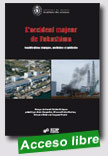 |
L'accident Majeur de Fukushima - Considérations Sismiques, Nucléaires et Médicales
Institute de France - Académie des Sciences, Mars 2012, 100 p.
Le 11 mars 2011, le district Nord-Est du Japon a été frappé par un tremblement de terre massif suivi d'un tsunami majeur et d'une série d'accidents à la centrale nucléaire de Fukushima avec fuites d'éléments radioactifs". Tel est le message que le professeur Kanazawa, président du Science Council of Japan adressa quelques jours après la catastrophe aux présidents des académies des sciences étrangères, ajoutant qu'il |
nourrissait l'espoir que ces académies aideraient à la réhabilitation nécessaire.
L'Académie des sciences décida aussitôt de former un groupe de travail avec pour mission d'analyser les événements survenus au Japon et de faire le point sur les risques sismiques et nucléaires tels qu'ils se posent en France.
Le groupe de travail comprenait trois sous-groupes réunissant les compétences nécessaires à l'étude des trois composantes – sismique, nucléaire et sanitaire – de ce drame. Pour chacune de ces composantes, objets des trois parties de ce rapport, l'analyse des événements observés à Fukushima a été complétée par une réflexion sur les forces et faiblesses de ces domaines en France, de façon à formuler les recommandations qui s'imposent et à répondre aux questions d'ordre scientifique et sociétal que le public se pose. Bien que des incertitudes demeurent et que de nouvelles informations viennent encore chaque mois enrichir le dossier, ce rapport a paru suffisamment abouti pour être publié en l'état au lendemain de la date anniversaire de ce drame qui continuera longtemps à nous interpeller.
Annexes
Extraído de: http://www.academie-sciences.fr/activite/rapport/rads0611.htm
|
 |
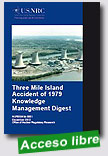 |
Three Mile Island Accident of 1979 Knowledge Management Digest (NUREG/KM-0001)
United States Nuclear Regulatory Commission, December 2012, 24 p.
Although it caused no deaths or injuries, the accident at the Three Mile Island, Unit 2 (TMI-2) nuclear power plant was the most serious incident in U.S. commercial nuclear power history. The accident began in the early morning hours of March 28, 1979, at the power plant near Middletown, PA, and its effects on nuclear safety and regulation continue to this day. Three Mile
|
Island spurred the U.S. Nuclear Regulatory Commission (NRC) to tighten and heighten its regulatory oversight of the nuclear power industry to ensure safety for the public and the environment. Investigations and the implementation of lessons learned brought about sweeping changes in the U.S. nuclear industry. These included improvements in emergency response planning, reactor operator training, human factors engineering, radiation protection, and many other areas of nuclear power plant operations. The NRC has intensively studied and documented the TMI-2 accident.
This multimedia knowledge management digest is the first in the NRC’s NUREG knowledge management (NUREG/KM) series. The agency intends for NUREG/ KMs to preserve knowledge for future generations of the important historical events and research that have shaped the NRC’s regulatory programs.
This knowledge management digest and the supporting DVD contain the reports that the NRC and other government organizations issued following extensive investigations in the accident. Although a few key documents have become available electronically, this NUREG/KM marks the first time that the NRC has digitized these historically important reports. On the DVD, the table of contents on the main welcome screen lists these reports and provides access to them.
In addition to the large collection of reports, the DVD also provides a multimedia presentation of the special NRC event, "The Accident at Three Mile Island—A Look Back: Preserving the Institutional Memory after 30 Years.
Extraído de:http://www.nrc.gov/reading-rm/doc-collections/nuregs/
knowledge/km0001/?utm_source=Paulo%27s
+Corner+Daily+Nuclear+News+Digest&utm_campaign=a2ab3af693-
RSS_EMAIL_CAMPAIGN&utm_medium=email#pub-info
|
 |
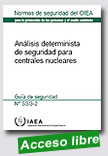 |
El objetivo de esta Guía de Seguridad es formular recomendaciones y orientaciones sobre el análisis determinista de seguridad para diseñadores, explotadores, reguladores y organizaciones de apoyo técnico. También ofrece recomendaciones sobre el uso del análisis determinista para: a) Demostrar o evaluar el cumplimiento de requisitos reglamentarios;
|
b) Determinar posibles mejoras de la seguridad y la fiabilidad; c) Conseguir una mayor flexibilidad operacional dentro de los límites de la seguridad para las centrales nucleares.
Las recomendaciones se basan en las buenas prácticas actuales de centrales nucleares de todo el mundo y proceden fundamentalmente de la experiencia obtenida en la realización de análisis de transitorios y análisis de accidentes para centrales nucleares.
Extraído de:
http://www-pub.iaea.org/MTCD/Publications/PDF/Pub1428s_web.pdf
|
 |
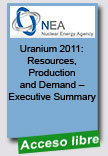 |
Uranium 2011: Resources, Production and Demand – Executive Summary
Nuclear Energy Agency (NEA), 01/11/12, 8 p.
In the wake of the Fukushima Daiichi nuclear power plant accident, questions are being raised about the future of the uranium market, including as regards the number of reactors expected to be built in the coming years, the amount of uranium required to meet forward demand, the adequacy of identified uranium resources to meet that demand and the ability of the sector to meet reactor requirements in a challenging investment |
climate. This 24th edition of the “Red Book”, a recognised world reference on uranium jointly prepared by the OECD Nuclear Energy Agency and the International Atomic Energy Agency, provides analyses and information from 42 producing and consuming countries in order to address these and other questions. It offers a comprehensive review of world uranium supply and demand as well as data on global uranium exploration, resources, production and reactor-related requirements. It also provides substantive new information on established uranium production centres around the world and in countries developing production centres for the first time. Projections of nuclear generating capacity and reactor-related requirements through 2035, incorporating policy changes following the Fukushima accident, are also featured, along with an analysis of long-term uranium supply and demand issues.
Français
Extraído de:
http://www.oecd-nea.org/tools/publication?query=&div=&lang=
&period=6m&sort=title&filter=1#p7059 |
 |
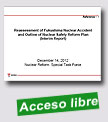 |
Reassessment of Fukushima Nuclear Accident and Outline of Nuclear Safety Reform Plan (Interim Report)
Nuclear Reform Special Task Force, December 14, 2012, 22 p.
We submitted a construction permit application including specifications of nuclear power generation facilities, safety design policy and results of safety analysis to the government in July, 1966 in order to obtain a construction permit for Fukushima Daiichi Nuclear Power Station. In the application, we explained
|
that multiple facilities would work reliably; cooling and shutting down of the nuclear reactors and preventing the discharge of radioactive substances. However, the earthquake and tsunami of March 11, 2011 disabled most of the functions of these safety facilities, which were assumed to be effective in handling accidents. ( This was caused by a lack of consideration for common cause failures due to external events (earthquake and tsunami) at the design phase. In addition, sensitivity for overseas safety measures such as U.S. antiterrorist measures (B5b) was low and continuous safety improvements of the facilities were not enough. Official information about B5b was not disclosed because of its characteristics as an antiterrorist measure. However, we will study overseas trends on safety measures more carefully, and increase the sensitivity of risk.
We deeply regret this severe accident including a meltdown of the reactor and the release of large amounts of radioactive substances due to a subsequent lack of effort in continuous safety improvements.
Extraído de:
http://www.tepco.co.jp/en/press/corp-com/release/betu12_e/images/121214e0201.pdf
|
 |
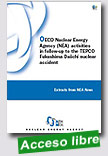
|
OECD Nuclear Energy Agency (NEA) follow-up to the TEPCO Fukushima Daiichi nuclear accident
Nuclear Energy Agency (NEA), 2012, 16 p.
The NEA has undertaken a number of activities following the March 2011 accident at the Fukushima Daiichi nuclear power plant in Japan. This brochure contains three extracts from NEA News published in the months following the accident: Fukushima (what happened, consequence, follow-up), published June 2011; Fukushima: liability and compensation, published December 2011; and The NEA integrated response to
|
the Fukushima Daiichi nuclear accident, published June 2012. Together these extracts allow the reader to understand better the causes, consequences and importance of the NEA’s response to the Fukushima Daiichi accident (2012).
Extraído de:
http://www.oecd-nea.org/tools/publication?query=&div=
&lang=&period=6m&sort=title&filter=1#p6888 |
 |
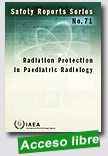 |
Radiation Protection in Paediatric Radiology
IAEA Safety Reports Series, 2012, 111 p.
This publication provides guidance to radiologists, other clinicians and radiographers/technologists involved in diagnostic procedures using ionizing radiation with children and adolescents, and should also be of value to medical physicists and regulators. It focuses on the measures necessary to provide protection from the effects of radiation using the principles established in the IAEA’s International Basic Safety Standards for Protection against Ionizing Radiation and for the Safety of |
Radiation Sources, and the priority accorded to the area. The emphasis throughout is on the special requirements of paediatrics.
Extraído de: http://www-pub.iaea.org/books/IAEABooks/8727/Radiation-Protection-in-Paediatric-Radiology
|
 |
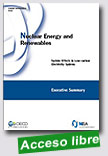 |
Nuclear Energy and Renewables – System Effects in Low-carbon Electricity Systems - Executive Summary
Nuclear Energy Agency (NEA), 2012, 16 p.
This report addresses the increasingly important interactions of variable renewables and dispatchable energy technologies, such as nuclear power, in terms of their effects on electricity systems. These effects add costs to the production of electricity, which are not usually transparent. The report recommends that decision-makers should take into account such system costs and internalise them according to a “generator pays” principle, |
which is currently not the case. Analysing data from six OECD/NEA countries, the study finds that including the system costs of variable renewables at the level of the electricity grid increases the total costs of electricity supply by up to one-third, depending on technology, country and penetration levels. In addition, it concludes that, unless the current market subsidies for renewables are altered, dispatchable technologies will increasingly not be replaced as they reach their end of life and consequently security of supply will suffer. This implies that significant changes in management and cost allocation will be needed to generate the flexibility required for an economically viable coexistence of nuclear energy and renewables in increasingly decarbonised electricity systems.
Extraído de: http://www.oecd-nea.org/tools/publication?query=&div=&lang=
&period=6m&sort=title&filter=1#p7066
|
|
|
|
|
|
|
|
|
|
|
|
